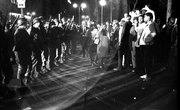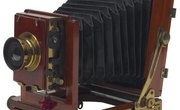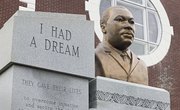The atomic age of the 1950s came with the advent of both the hydrogen bomb and the nuclear power station. It also involved endless political debates about the ethics of nuclear war and the pros and cons of atomic power. Not surprisingly, this fascination with the everything atomic in the 1950s was then also reflected in the culture of that decade, from its literature and fine art to comic books and motion pictures.
Nuclear Optimism at Home
While many people saw nuclear power as a terrifying threat, others were more optimistic. The atomic culture of the time lead to atomic symbolism being used as a metaphor for a brighter, cleaner future. For example, the Atomium building in Brussels, Belgium, was built of stainless steel to resemble an atom. The 330-foot structure was constructed for the 1958 World's Fair and is still standing today. The surrealist painter Salvador Dali also used atomic symbolism in a positive way. He referred to the style he adopted during the 1950s as "nuclear mysticism." On the home front, the atomic energy symbol was integrated into everything from fabric to wall decor as a design trend of the decade.
Atomic Age Art in Comics
The possibility of nuclear war was in everyone's mind in the 1950s. One of the first depictions of such a war was presented in the comic book "Atomic War," which was published in four issues during 1953 and 1954. The ostensible purpose of the comic was to highlight the horrors of nuclear war, but there was an element of glamorization as well. That wasn’t the case with the 1958 novel "Red Alert" by Peter George, whose bleak vision was turned into "Dr. Strangelove" a few years later.
Atomic Bomb Movie Monsters Attack
The "monster movie" was one of the most iconic products of 1950s popular culture. In many cases, the featured monster was supposedly the result of a nuclear mishap. This is the case in two of the best-known science fiction movies of 1954, "Them," featuring giant ants created near the scene of an atomic test, and the Japanese classic "Godzilla." Atomic bomb movie monsters were the perfect way to symbolize the fear and helplessness that many people felt in the face of nuclear weapons.
Reactions in the Media
The growing anti-nuclear movement in the 1950s was reflected in the work of writers such as Philip K. Dick. Many of his early novels and short stories are concerned with the devastating after-effects of nuclear war. A common trope of the 1950s was the idea of extraterrestrials coming to Earth to warn of the dangers of atomic weapons. This atomic theme played out in the 1951 film "The Day the Earth Stood Still" and was subsequently echoed in numerous UFO encounters that were presented as being real, such as those of George Adamski.
Related Articles
References
Resources
Writer Bio
Andrew May has more than 25 years of experience in academia, government and the private sector. A full-time author since 2011, he wrote "Bloody British History: Somerset" and "Pocket Giants: Isaac Newton" (to be published in 2015). He is a regular contributor to "Fortean Times" magazine, and also contributed to "30-Second Quantum Theory." May holds a Master of Arts in natural sciences from Cambridge University and a Ph.D. in astrophysics.










